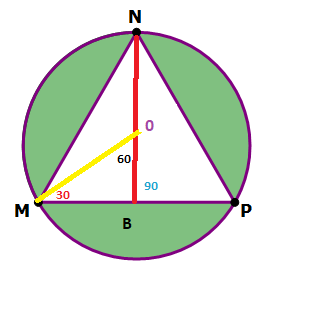Bunuel wrote:

In the diagram, triangle MNP is equilateral.

A. The quantity in Column A is greater
B. The quantity in Column B is greater
C. The two quantities are equal
D. The relationship cannot be determined from the information given
Kudos for correct
solution.
Attachment:
The attachment gqgpp_img7.png is no longer available
Attachment:
The attachment gqgpp_img8.png is no longer available
Attachment:
 #greprepclub In the diagram, triangle MNP is equilateral..png [ 12.78 KiB | Viewed 4820 times ]
#greprepclub In the diagram, triangle MNP is equilateral..png [ 12.78 KiB | Viewed 4820 times ]
An equilateral \(\triangle\) inscribed in a circle, the altitudes of from each vertex meets at a common point
O. The distance from the tip of the vertex to the point
O is the radius of the circle
Here,
For easy calculation, let take the radius = 2 ( it can be any value)
MO = radius of the circle = 2
since, MNP is equilateral \(\triangle\)
so, \(\angle\) OMP = 30
\(\angle\) OBM = 90
\(
\angle\) MOB = 60
Hence, the \(\triangle\) MOB is a 30:60:90 triangle and the sides are divided in the ratio as 1 : \(\sqrt{3}\) : 2
We know, OM = 2
therefore, MB = \(\sqrt{3}\)
and OB = 2
Now,
area of the circle = \(\pi * 2^2\) = \(4\pi\)
Area of the equilateral \(\triangle \)= \(\frac{{\sqrt{3}}}{4}\) * \({side}^2\)
= \(\frac{{\sqrt{3}}}{4}\) * \({2\sqrt{3}}^2\)
= \(3\sqrt{3}\)
Area of the shaded region = \(4\pi\) - \(3\sqrt{3}\)
QTY A = \(3\sqrt{3}\)
QTY B = \(4\pi\) - \(3\sqrt{3}\)
adding \(3\sqrt{3} \)
QTY A = \(6\sqrt{3}\)
QTY B = \(4\pi\)
Hence QTY A < QTY B









 52% (02:25) correct
52% (02:25) correct



